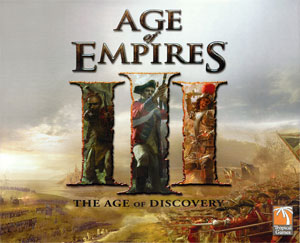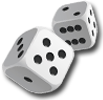Age of Empires III Board Game Review
 Stats:
Stats:
No. of players: 2-5
Amount of time to play: 120 min – 150 min
Age requirements: 10+
Set-up time: 5 minutes
Age of Empires III is a worker placement game where you must colonize the New World. The game takes place over three ages. After eight turns the game is over and you must have the most victory points to win.
Age of Empires III Rules Description:
Age of Empires III also goes by the title Glenn Drover’s Empires: The Age of Discovery. I believe the license to use Age of Empires from Microsoft was lost.
You start the game with five colonists and ten dollars. There are two types of workers, colonists and specialists. On your turn you must place one of your workers on one of the following event tracks: initiative, colonist dock, trade goods, merchant shipping, capital buildings, discovery, specialists or warfare. Once everyone has placed all their workers, the event tracks are resolved from top to bottom. Each individual event track has a limited number of spaces and they are resolved from left to right.
The initiative track gets you a bit of money and determines your turn order for the following turn. Any workers placed in the colonist docks go to the New World. You can collect a trade good for each worker on the trade good event track. These goods are refreshed each round. Each colonist or specialist in the helps you gain a merchant ship. Colonists on the capital buildings track allow you to pay to build a building. The buildings refilled to five each round and refreshed between ages. Buildings advance and are more expensive each age. The discovery track lets workers stay there from round to round. Once you are ready you can declare that those workers are going on an expedition. This lets them discover new territories. But in order to be successful they must outnumber the natives. The specialists track lets you add specialist to the colonists you will place the next round. And the warfare track allows you to pay to attack with your soldiers.
There are four types of specialists, captains, merchants, missionaries, and soldiers. Captains count as two units in the merchant shipping track and on expeditions of discovery. Merchants can be used on the merchant shipping track to count as two units or on the colonist dock to gain five dollars when they arrive in the New World. Missionaries that go to the New World via the colonist dock automatically generate a colonist in the territory they are placed in. Soldiers can generate a one-time income on expeditions of discovery or be used in warfare to eliminate other players.
After resolving the event tracks, you gain income from your trade goods. You collect money based on sets of goods. Merchant ships can be used as wild cards to complete sets. Sets are made up of three or four goods.
After the board is refilled and refreshed you advance the turn marker. You then take five colonists plus any specialists you gained and begin the next turn.
Between each age you score VPs. If one player has three or more workers in a territory it scores. The player with the most workers gains six VPs, and the player with the second most gets two points. If there is a tie for first then both players get two VPs and no one else scores there.
After eight rounds the game ends and you get points for your discovery tiles gained through expeditions, capital buildings that have end game scoring, VPs equal to your income, and the last scoring of the territories in the New World. The player with the most VPs wins the game.
Quick Review of Age of Empires III:
Age of Empires III is a worker placement game with a bit of area control and a dash of set collection. It is a fun Eurogame with some direct conflict. And though it may take the first age to really grasp, it is easy to teach and learn.
The components for this game are top-notch the figures land are look great and the money is plastic coins. The rules are easy to read and understand too. The box is not so great. It really should have an insert and though not a big deal it is kind of annoying.
I like the multiple paths to victory in Age of Empires III. You can discover, get trade goods that work in conjunction with one of your capital buildings or just try to control the New World. All of these strategies or a mix of them are possible ways to winning the game. This even adds to the replay value of the game as you try different tactics to get to the top.
My next like is tied into the first one, it is game balance. The strategies above are pretty balanced and the randomness of the tiles ensures that one strategy does not dominate. The buildings are not balanced, but since they’ll come out at different times you must think on your feet and get the buildings you want when they appear.
I only have two gripes about this game. One I just mentioned is the unbalanced buildings. This is not too big a deal except for one Age I building that lets you buy two more buildings with its income. Many players remove this building from the game or at least ensure it shows up after the first or second turn. My other complaint is pretty small. It is hard to tell the figure apart. You can paint them or just pay attention, but new players may get confused since they look a lot alike.
All said and done I really enjoy this game. It is a nice medium-weight, worker placement game that is not too long. If you enjoy the theme or worker placement game, you should try Age of Empires III out. You’ll probably discover you like it!
Score and synopsis: (Click here for an explanation of these review categories.)
Strategy 5 out of 6
Luck 4 out of 6
Player Interaction 5 out of 6
Replay Value 5 out of 6
Complexity 4 out of 6
Fun 5 out of 6
Overall 5 out of 6


Leave a Reply